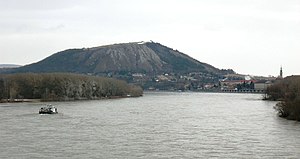Braunsberg (Hundsheim Mountains)
| Braunsberg | ||
|---|---|---|
|
Braunsberg from the west, in front of it the Danube |
||
| height | 346 m above sea level A. | |
| location | Lower Austria | |
| Mountains | Hundsheim Mountains , Carpathian Mountains | |
| Dominance | 2.13 km → Hundsheimer Berg | |
| Notch height | 185 m ↓ Hainburg | |
| Coordinates | 48 ° 9 '12 " N , 16 ° 57' 27" E | |
|
|
||
The Braunsberg is a 346 m high limestone hill near Hainburg an der Donau (eastern Lower Austria ). The unusually shaped mountain with its sloping plateau was a city mountain of the Celts and still bears clear traces of the Celtic-Roman era.
An obstacle for the Danube
The brown mountain provides with the other in the Slovakia located Thebener Kogel (devínska kobyla) the Hainburger or Hungarian gate (Porta Hungarica) of the Danube stream . The water gap when Braunenberg is a geological link between Alps and Carpathians .
A road leads from Hainburg to the summit. The Braunsberg offers an excellent view of the Hundsheimer Mountains , the Danube and the city of Bratislava and its surroundings as well as far into the Marchfeld. On the mountain is the memorial of the Carpathian Germans in memory of their old homeland in Slovakia.
history
The Braunsberg lies in an area that has been inhabited for 7000 years. There was an important Celtic hilltop settlement ( oppidum ) on the mountain, a hill fort that was built in the 2nd century BC. Was built. Archaeological investigations have been ongoing since 1986, in the course of which a Celtic rampart and a watchtower have been reconstructed.
This settlement, which was inhabited by the older Hallstatt ( Calendar Mountain Group) until the later Latène period , has been described since 1876; the first real excavations took place from 1931. The latène period earth wall with palisade encloses an area of around 23 hectares. Metalworking workshops and residential buildings with coin finds described as early as the 18th century are located inside the fortifications. According to recent excavation results, the settlement on the Braunsberg was already in the middle of the 1st century BC. Abandoned - long before the Roman conquest of the area. The assumption expressed by Velleius Paterculus in his Historia Romana (“Roman History”, II 109.5) that the hillside settlement is identical to “Carnuntum, a (em) place in Regnum Noricum ” is not proven by the excavation results. In fact, the Noric Carnuntum (from * karn , "rock") is equated with Devín on the Theben Castle Hill.
At the foot of the Braunsberg, towards the Danube, the Röthelstein Castle (also Rottenstein ) stood from the middle of the 12th century , which fell into disrepair in the 15th century and was then destroyed by the Turks. Today some remains of the wall are still preserved. On the other side of the river, where the March coming from Moravia empties, there are also fortresses of the Slovak city of Devín (Thebes).
Flora and fauna

Due to its location on the edge of the Pannonian lowlands , the Braunsberg has a favorable climate. Many warmth-loving, Mediterranean animal and plant species find ideal living conditions here, such as the green lizard , the Aesculapian snake , the lotus ( Onosma austriaca ), the Phoenician mullein ( Verbascum phoeniceum ) or the dwarf iris ( Iris pumila ). Some species are endemic on the mountain and in its surroundings , such as the Hainburg spring carnation ( Dianthus lumnitzerii ).
Web links
Individual evidence
- ^ Hainburger Stadtmuseum Wienertor
- ^ Susanne Sievers / Otto Helmut Urban / Peter C. Ramsl: Lexicon for Celtic Archeology. A-K and L-Z ; Announcements of the prehistoric commission in the publishing house of the Austrian Academy of Sciences , Vienna 2012, ISBN 978-3-7001-6765-5 , p. 234 f.

